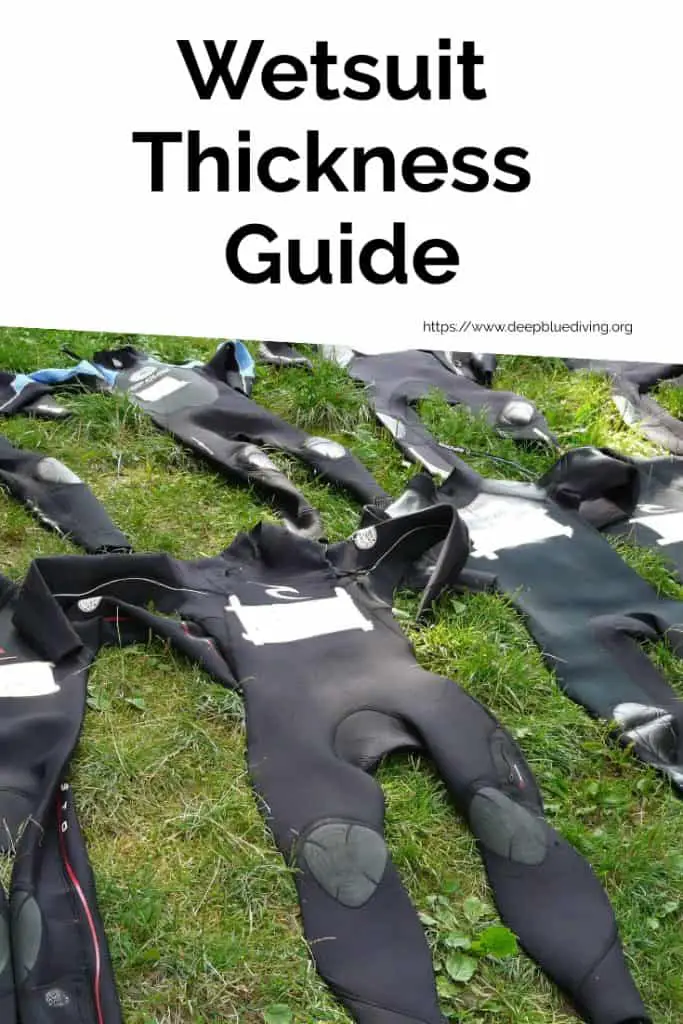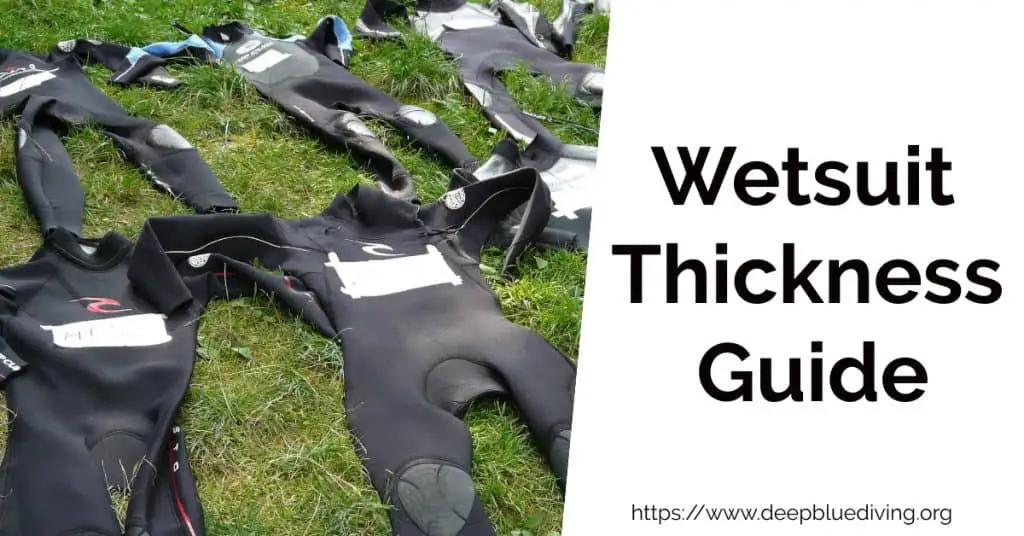Wetsuit Thickness Guide – Is Thick Neoprene Keeping You Warm?
Have you ever asked yourself, what wetsuit thickness do I need? Are you concerned about your comfort level while scuba diving? Not sure which wetsuit would provide the ideal water temperature for you? Confused about what a 3/2 wetsuit is?
We are providing the ultimate guide for wetsuit thickness that will help you find the ideal wetsuit for your needs. This guide will also help you determine what thickness wetsuit to choose and buy.
Why Do You Need A Wetsuit?
The wetsuit is necessary to protect you from the water temperature and provides flexibility while swimming. It can also keep you safe from other small swimming creatures like jellyfish attacks.
The wetsuit helps prevent fatigue while swimming. The cooling down and overheating actions of the body both consume energy and lead to a loss of power. When you wear the suit, your body temperature will be maintained at a more constant level. This helps save a lot of energy and allows you to swim for longer.
The risk of injury is also lower with a wetsuit. It acts as a layer to protect your body in case of a brush with the ocean bed and coral reef. The wetsuit keeps your muscles, ligaments, and tendons heated and therefore more flexible.
How Do Wetsuits Work?
A short science lesson here; Water molecules are good conductors of heat. They transfer energy between different surfaces much faster than air molecules. You may have noticed that on a normal 55-degree day you can stand comfortably outdoors in jeans and a shirt but you will probably start to shiver within minutes while swimming in the same temperature of the water.
A scuba diving wetsuit is an insulation suit made for protection and warmth in water sports and activities. It works by trapping a thin layer of water within the suit that acts as a barrier between your body and the water. The layer of water becomes warm due to your body’s heat and prevents you from losing too much heat while you are in the water.
Wetsuits are not designed to keep you completely dry. They are made with a material called Neoprene, which is built with small closed cells filled with air. These cells act as insulators against cold water by trapping heat inside.
How Does Thickness Affect Insulation?
The wetsuit’s thickness varies based on the amount of material used. The more neoprene in the suit, the warmer it will be when worn underwater. This is because a thicker wetsuit has more heat-trapping insulation. This is why it is important to research the temperature of the water you will be swimming in before getting a wetsuit.
If the region where you will swim is colder, you will need a thicker wetsuit. You may want to consider using gloves, boots, and a hood as well. If the region has a mild or even warm water temperature, the thickness should be lower.
Open Cell compared to Closed Cell Wetsuits – Which to use for Scuba Diving?
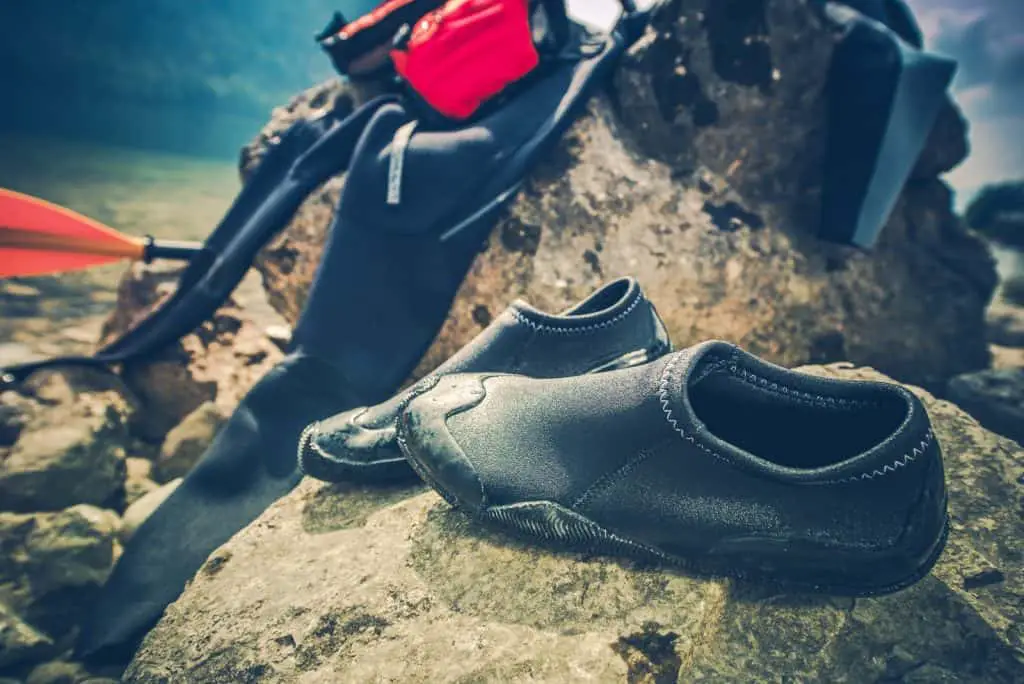
What do you wear under a Wetsuit? Specific wetsuit base layers for female or male?
How Was The Wetsuit Invented?
The diver’s wetsuit origins can be traced back to the commercial fishing and undersea salvage industries of the early twentieth century. The very first Mark V suits were invented to give divers a way to reach lower depths of water while protecting them from injuries from protruding rocks and sharp objects underwater.
These early suits looked similar to a modern space suit and much bulkier than current wetsuits. The suits were developed further during the first and second world wars and used by the navies. They were extensively used by the U.S. Navy Frogmen during the Second World War.
Modern Wetsuits
The modern wetsuits currently in use were significantly improved during the 1950s decade. The neoprene wetsuit was invented by Hugh Bradner. He was a physicist who was working for the University of California, Berkeley. Bradner wanted to improve the equipment that was used by the U.S. Navy and worked on a variety of projects.
The first models of these wetsuits sandwiched a very thin layer of neoprene between layers of nylon or spandex. These wetsuits worked by trapping a thin layer of water between the body and the suit. This water would become heated by the body’s temperature and acted as a shield from the water outside.
Significant improvements were made for the seams and stitches of these new wetsuits. These stitches kept the suit watertight and prevented the water outside from entering the suit. This kept the suit warmer and allowed the diver to swim underwater longer.
When Bradner made his first application for patent, it was rejected because the suit was considered to be too similar to a flight suit. When he tried to market the wetsuit to the U.S. Navy, it was rejected. The Navy was concerned that the gas that is inherently present in neoprene would make the divers visible on sonar.
The wetsuit was commercially taken up by the O’Neill Company, in1952. The business was owned by Jack O’Neill. He started manufacturing and supplying the early neoprene wetsuits in his garage. The business marketed the wetsuit with the motto, “It’s always summer on the inside.” Another company named Body Glove started commercializing the wetsuit around the same time. It was owned by Bob Meistrell, a surfer and professional diver.
These early neoprene wetsuits were not very easy to put on or reliable. They were made specifically for professional divers and scavengers and quite expensive. They were also not very sturdy and could be easily torn apart by pulling and stretching. Professional divers had to sprinkle talc on their bodies before putting their wetsuits on. After a few years, wetsuit manufacturers began lining the suits with nylon on the inner layer so that they would be easier to put on.
What Does Wetsuit Thickness Mean?
The wetsuit thickness determines how warm it will be underwater. The temperature also depends on other factors such as the material used and the design of the wetsuit. However, thickness remains the most important factor.
If you have been looking to get a wetsuit for a vacation, take a closer look at the wetsuit description in the store or the online surf shop. You will notice that it has two or three numbers listed in the wetsuit description in the style of 4/3. These numbers show you the thickness of the neoprene used in the wetsuit in millimeters.
The thickness of the material varies for different parts of the body. Typically, areas like the spine where your nervous system runs will have better insulation than arms and legs. This is why the suit uses different numbers in the description.
The wetsuit neoprene is also thinner on the arms and legs to allow better movement for the surfer’s limbs. Thinner insulation on the limbs ensures that swimmers are not overly restricted when surfing or scuba diving.
Wetsuit Thickness and Temperature Guide
The numbers on the wetsuit are usually separated with a ‘/’ or a ‘0’. Each number identifies the thickness for a specific part in millimeters.
The first number, which is usually the largest, identifies the thickness of the wetsuit at the torso. The second number gives the thickness of the neoprene on the limbs. If there is a third number, then the second number gives the thickness for the legs while the third number shows the thickness on the arms.
Here are some common examples of wetsuit thickness based on numbers.
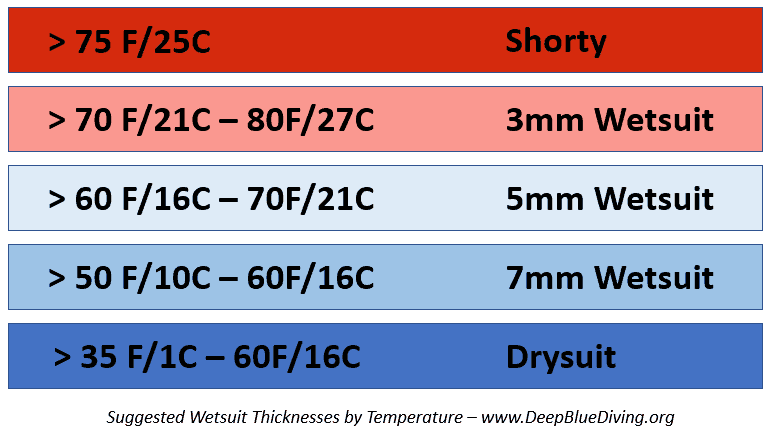
6/5/4mm Cold Water Armor – Hooded Full Wetsuit
This is one the thickest class of commercially available wetsuits commonly used in very cold water. The suit has a thickness of 6 mm on the torso and head. The legs are 5 mm in thickness and the arms are 4 mm thick.
The suit can be very cumbersome and restricts ease of movement but keeps you warm even in temperatures as low as 40°F. This is why the thickness is kept lower on the limbs. A wetsuit with 6 mm neoprene all over would be very restrictive and make it very difficult to paddle or surf.
5/4/3mm Bitter Cold Barrier – Epic Wetsuit
This is also a cold water wetsuit, ideal for temperatures between 45°F and 55°F. This type of wetsuit should be worn by a scuba diver or surfer through winter when scuba diving in Northern Europe or the Coast of Northern America.
The torso material is 5 mm thick, the legs and arm are 4mm and 3mm respectively.
4/3mm Winter Warmth – Full Back Wetsuit
Ideal for winter-like conditions, this wetsuit has a 4mm torso and 3mm thickness for limbs. It can be used in water temperatures from 52°F to 60°F.
3/2mm Mid Season – Full Back Wetsuit
This is a popular wetsuit that can work in the winter, spring, or fall seasons. The torso is 3mm and the limbs are 2mm thick. It is significantly thinner than the winter, cold water wetsuits, and ideal for the Caribbean, US Coast, and Southern Europe scuba diving.
2mm Lightweight – S/S Full Back Wetsuit
This suit only has 2mm because the torso and limbs are both the same 2 mm thickness. It is suitable for spring and early summer water activities. This suit offers maximum movement and flexibility.
What Thickness Wetsuit Do You Need for Diving?
The thickness of the wetsuit you should buy depends on the season, where you are going, and how deep you will dive. If you are planning to surf off the coast of Canada or go scuba diving around the British Isles in winter then you should obviously go for maximum protection of the 6/5/4 mm suit.
If you are scuba diving in the Caribbean during the summer then you should be ok with a 2mm wetsuit. You can even get a half-body wetsuit without limbs to get protection for the torso while still allowing you full freedom of movement.
What Types of Wetsuits Can You Get?
There are factors other than thickness to consider when buying a wetsuit for scuba diving. These include the type of wetsuit, the location of the wetsuit zip, how the suit fits, and the color of the wetsuit. It is important to consider all these factors before you buy a wetsuit.
Let’s briefly review all the available options.
Full Wetsuits
The Full Wetsuit, aka Long Arm Steamer is ideal for cold water scuba diving. It comes in a variety of wetsuit thicknesses from 2 mm to 8 mm. For very cold weather you would need a 6mm or even 7mm wetsuit. For mildly cold temperatures a wetsuit of 3mm/2mm would get the job done.
Most full wetsuits come with attached hoods for the headcover. A 6mm full wetsuit with attached hood, wetsuit boots, wetsuit gloves, and a heated rash guard will let you stay in the water much longer.
Short Wetsuits
The Short Wetsuit is built to provide maximum heat while still allowing you complete freedom of movement. It is made with a mix of 4mm to 2mm neoprene that covers the trunk, thighs and upper arms. It leaves the forearms and lower legs exposed, allowing you to paddle comfortably and with ease.
Long John or Jane Wetsuits
The Long John or Jane wetsuits give your full body coverage for the torso and legs. It leaves your arms fully uncovered, starting from the shoulders. This wetsuit is great for paddling underwater without exerting a lot of effort. You can flail your arms around with no neoprene resistance.
The Long John or Jane is excellent for swimming conditions where the air temperature is warm but the temperature underwater is a little chilly. It is generally used for surface and shallow water scuba diving.
Wetsuit Tops and Bottoms
If you cannot find a single wetsuit that you like, you can also get the top and bottom separately. Wetsuits are available in two separate pieces from most suppliers. You can get the top wetsuit as a vest or jacket and the bottom as pants or shorts. You can also get customized thicknesses depending on what you want.
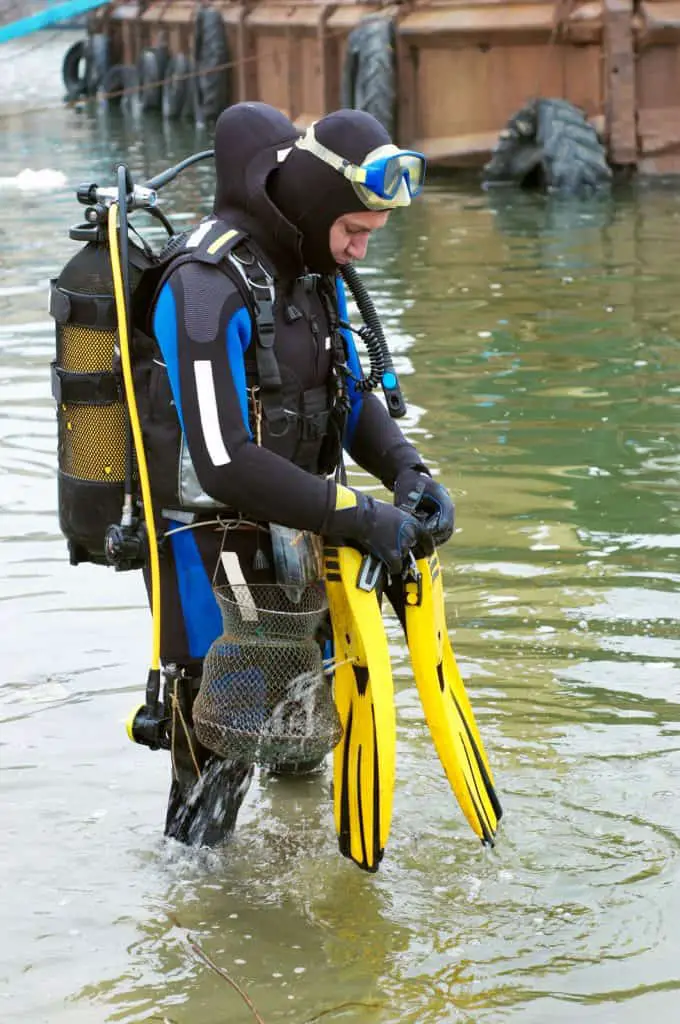
Do You Need A Wetsuit When Diving in the Tropics?
People have different definitions for what they consider cold. Some would find a water temperature of 75°F quite chilly and prefer to get a full wetsuit for the water. Others may swim at 65°F and still opt for just a vest and shorts.
Tropical seas are defined as water bodies that lie between the temperate zones. Although the water temperature depends on the currents and time of the year, it is still relatively stable around 65°-86° Fahrenheit.
Scuba divers prefer to dive in tropical locations. Warm water is more popular as a diving location than cold water scuba diving. This is mainly due to the comfort of the diver while underwater. Tropical locations do not require you to wear thick, cumbersome wetsuits.
However, you may still find it better to get a wetsuit, even when you are scuba diving in a tropical place. There are short, sleeveless wetsuits available that only cover the torso and allow you maximum ease of movement while still protecting you from the cold temperature.
Does A Wetsuit Allow You to Dive Longer?
Yes. Prolonged exposure to chilly water can consume your energy quickly. It can also have a harmful effect on your body.
A wetsuit is designed to protect you from the cold and maintains a warm body temperature. A wet suit allows you to stay underwater significantly longer than you would be able to dive without a wetsuit.
The only exception is when you are scuba diving in a warm location during the summer. But even in this case, a wetsuit offers greater protection.
Final Thoughts
Wetsuit thickness affects how protected you are against the cold water and the ease of scuba diving underwater.
The thickness of the wetsuit you will need depends on the time of the year and where you are going for scuba diving. Destinations with a cool temperature require a thicker wetsuit while locations that are warmer can do with a thinner wetsuit. You may even manage without a wetsuit in very warm locations.
The wet suit is an important component of your underwater scuba diving adventure. Today, the wetsuits that are available in the market are quite sturdy and last for many years without causing any problems. They are also not that expensive to buy.
The wetsuit will also increase the length of time you can stay underwater and improve the overall scuba diving experience. It is highly recommended to get at least one wetsuit if you are serious about taking up scuba diving as a hobby.
